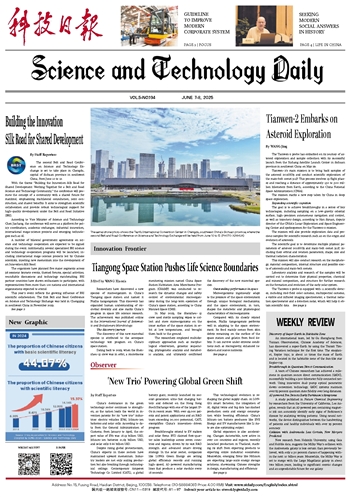
Researchers have discovered a new species of microorganism in China's Tiangong space station and named it Niallia tiangongensis. This discovery has expanded human understanding of microbial diversity and also marks China's progress in space life science research. The achievement was published online in the International Journal of Systematic and Evolutionary Microbiology.
The discovery journey
The discovery of this new microbial species is attributed to the aerospace technology test program on China's space station.
Dating back to 2023, when the Shenzhou-15 crew was in orbit, a microbiome monitoring mission named China Space Station Habitation Area Microbiome Program (CHAMP) was conducted to research the dynamic changes and safety control of environmental microorganisms during the long-term operation of China's space station, according to China Manned Space (CMS).
In May 2023, the Shenzhou-15 crew used sterile sampling wipes to collect and store microorganisms on the inner surface of the space station in orbit at low temperatures, and brought them back to the ground.
The researchers employed multidisciplinary approaches such as morphological observation, genomic sequencing, phylogenetic analysis and metabolic analysis, and ultimately confirmed the discovery of the new microbial species.
Outstanding performance in space
Microorganisms ingeniously adapt to the pressure of the space environment through unique biological mechanisms, and the space environment, in turn, shapes the metabolic and physiological characteristics of microorganisms.
Compared with its closely related species, Niallia tiangongensis performs well in adapting to the space environment. Its food mainly comes from skin debris remaining on the surface of the space station and gelatin from food debris. It can survive under extreme conditions such as microgravity, enhanced radiation and scarce nutrients.
Research shows that it can precisely respond to oxidative stress in space by regulating the biosynthesis of thiol in bacilli, maintaining the REDOX balance within cells, and thus ensuring its stable growth under extreme conditions. In addition, it has outstanding capabilities in the formation of biofilms and the repair of radiation damage.
In the closed environment of the space station, the reproduction of microorganisms may pose multiple risks to the health of astronauts and the safety of equipment. Therefore, astronauts must strictly implement anti-bacterial measures, and scientists have established a set of all-round microbial control mechanisms for space stations.
The space station currently has realized dynamic and real-time monitoring of microorganisms. In the future, it may combine AI predictions so that microorganisms have "nowhere to hide," said Xu Dan, professor at the School of Life Science and Technology, Xi'an Jiaotong University.
Incredible potential
The features of Niallia tiangongensis are expected to provide new ideas for space health security, the utilization of biological resources, waste treatment and the development of new materials.
Its SpIA protein efficiently repairs DNA damaged by cosmic rays, and its ability to form biofilms, which attaches to the surface of hardware, enhancing tolerance to microgravity and extreme temperatures, can inspire scientists to provide biotechnological support in areas such as space resource recycling, radiation protection and medical innovation for long-term manned missions, said Xu.
With the long-term operation of the space station, research on active substances, genetic resources and metabolic functions of microorganisms is expected to provide valuable research results, which will also bring new development opportunities for scientific research and applications on Earth.
Recently, the eighth batch of scientific samples from China's space station returned to Earth aboard the Shenzhou-19 manned spacecraft. In terms of life science, the samples include 20 types such as human induced pluripotent stem cells, bronchial epithelial cells, fruit flies and protein, according to the CMS.
Notably, three generations of fruit flies were continuously cultivated in a month after they were sent into space by the Tianzhou-8 cargo spacecraft. This research is the world's first to set up a submagnetic environment in a space station and explore the biological effects. It laid an important foundation for studying reproduction, growth, brain activities and behavior in the space environment, and also offers a scientific basis for the health guarantee of future human space voyages, said Li Yan, researcher at the Institute of Biophysics, Chinese Academy of Sciences.
More analyses and research will be carried out to provide theoretical support for human health security in space and on the ground, and contribute to deep space exploration and future manned space missions.

 Next
Next




